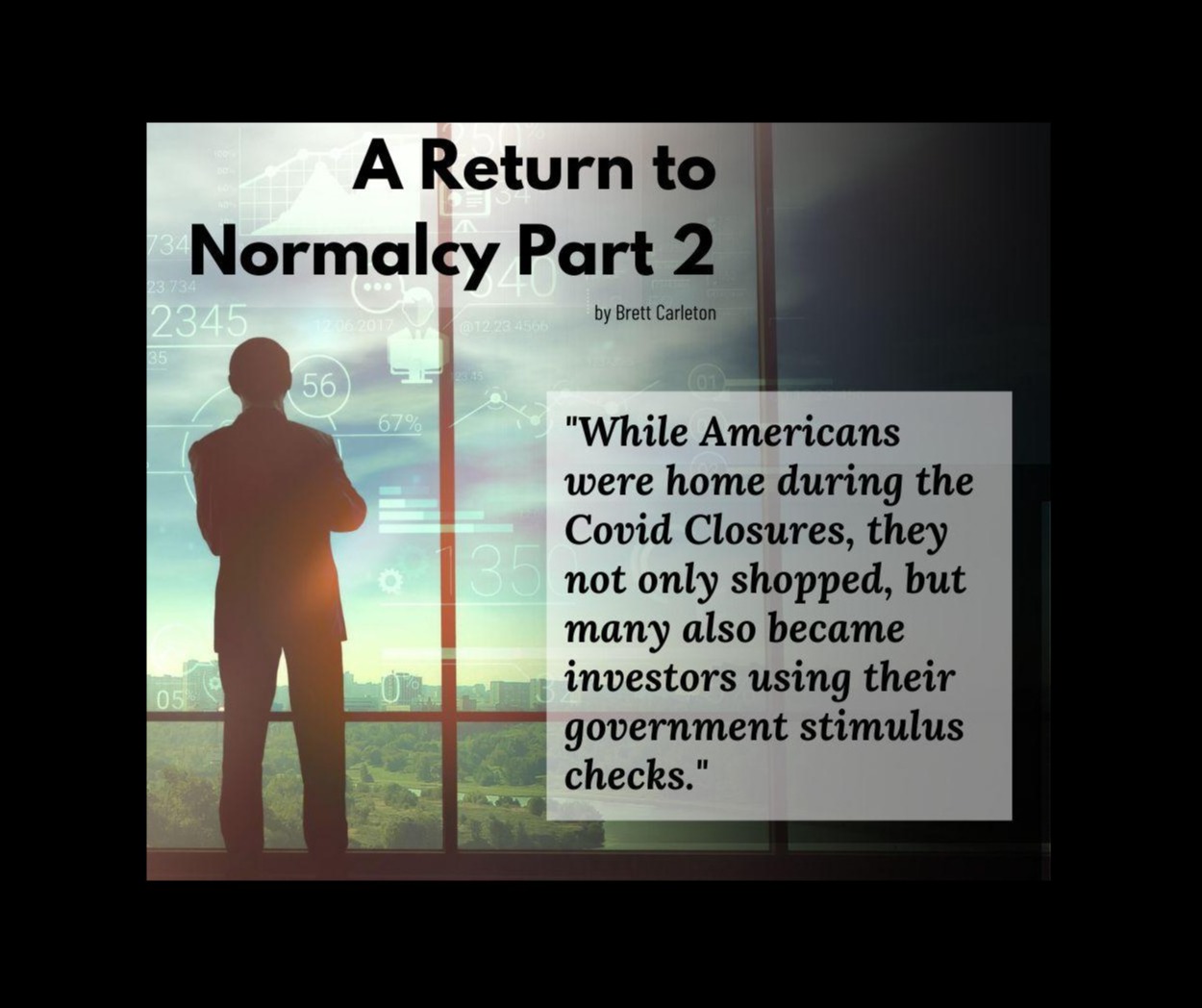
A Return to Normalcy Part 2
A Return to Normalcy Part 2 by Brett Carleton PDF Version
A Return to Normalcy Part 2
While Americans were home during the Covid Closures, they not only shopped, but many also became investors using their government stimulus checks. As someone that has been in the financial services industry for 34 years, it brought back memories from the past. It felt somewhat like the dotcom, day trading era of the late ‘90’s, also a bit like the Emu/Ostrich investment craze of the mid ‘90’s. I must confess that as a young man in the late ‘90’s, I couldn’t help myself but buy some of the high-flying tech stocks of that time like Cisco Systems, Dell, and Intel, just to name of few. It’s hard to imagine in today’s world of online, free stock trades, but this was the first-time investors could buy a stock on their computer without talking to a stock broker. Day trading absolutely exploded during this period with names like Pets.com, Webvan, and WorldCom (remember the sock-puppet commercials). With all these new investors and the demand they created for these high-flying stocks, U.S. equity markets went almost straight up for 5 years.
As the Federal Government sent stimulus checks out to Americans during Covid, the online brokerage firms all reported millions of these checks being deposited into new accounts. Well, we didn’t have dot com stocks to buy during covid, but these new investors discovered Crypto Currency, Meme stocks, along with all the Covid darlings (think Peloton, Zoom, Amazon-thank goodness for Amazon). Back in the ‘90’s, day traders made bets on companies with no earnings, and many with no prospect for earnings. During Covid, Robinhood investors were buying stocks of all, but dead companies based on a Reddit chat room (i.e., GameStop, AMC). Investors also bought stock in companies that experienced significant sales growth during Covid which helped drive the share prices of these companies to very rich valuations. Unfortunately, just like in 2000, the party always comes to an end, and the punch bowl is taken away. The Meme stock craze was short-lived as they got into regulatory issues, but exciting while it lasted. Even the Apples, Microsoft’s, & Amazons have all experienced significant drops in the price of their shares as the valuations became very stretched. During these bouts of euphoria, nothing matters to the “investor” but the prospect of missing out.
It never ceases to amaze me what people are willing to “invest” (speculate) in. Back in the early to mid ‘90’s, there was a belief, movement, rumor (I’m not sure what to call it), that Emu and Ostrich meat could replace beef here in the U.S. as a healthier alternative. Overnight, a breeding pair of Ostrich’s were selling for upwards of $15,000, with eggs selling for thousands of dollars each. As you are aware, this trend did not pan out and these investors could not give their birds away. Farmers wouldn’t take them because the cost to raise and feed them, was more than they could ever expect to get if they could sell the birds. Many of these birds were just released into the wild. During Covid, Beyond Meat Inc developed a meat alternative to beef that would change the way we “grow” our beef here in the United States. Apparently, Americans like their beef raised on a farm not grown in a lab. The stock price for Beyond Meat went through the stratosphere during this period, even though the company has never reported a profit. There is now speculation they will file for bankruptcy.
We live in a culture where we want everything now, that includes getting rich. There is something to be said about the get-rich-slowly method-spend less than you make, invest for the long-term, and don’t chase fads. So how did I do with my “Tech” investments back in the late ‘90’s. They all imploded with the bursting of the Dot.com bubble in early 2000, and I lost most of what I had invested. Having said that, this was one of those key learning moments in my life. My wife Laura and I are committed to spending less than we earn, investing money each month, supporting our favorite charities, and we do not speculate with our long-term investments. I am confident this will allow us to live the lives we hope for, support those organizations that are important to us, and leave something to the next generation.
Please share any memories or interesting experiences you have.


